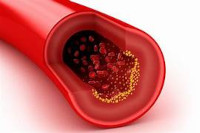Effect of Rosella (Hibiscus sabdariffa. L) Consumption on Total Cholesterol Levels http://www.doi.org/10.26538/tjnpr/v7i6.4
Main Article Content
Abstract
Heart disease is the leading cause of death in developed and developing countries. Increased and imbalanced cholesterol in plasma is a factor that can increase coronary heart disease incidence up to 2.52 – 3.20 at productive age. Drinks from Rosella can be used to treat hypercholesterolemia and hypertension. Rosella extract, containing anthocyanins with antioxidant properties, has been shown to reduce fat, Hyperlipidaemia, and heart disease. This study aimed to determine the effect of rosella (Hibiscus sabdariffa. L) infusion on body total cholesterol levels. The experimental method involves a pretest-posttest approach which measures plasma cholesterol values before and after a once-a-day intake of a glass of rosella steeping for 14 days. The result of the study shows an inverse relationship between the consumption of rosella steeping and cholesterol values, with an R-value of -0.378. The R Square value = 0.143 suggests that rosella steeping consumption affects total cholesterol levels by 14.3%. The study concludes a direct correlation between the
consumption of Rosella infusion on total cholesterol values, with a decrease in serum cholesterol values after Rosella infusion compared to before intake.
Downloads
Article Details

This work is licensed under a Creative Commons Attribution-NonCommercial-NoDerivatives 4.0 International License.
References
Malakar AK, Choudhury D, Halder B, Paul P, Uddin A, Chakraborty S. A review on coronary artery disease, its risk factors, and therapeutics. J. Cell. Physiol. 2019; 16812–23.
Kafeshani M, Entezari MH, Karimian J, Pourmasoumi M, Maracy MR, Amini MR and Hadi A. A comparative study of the effect of green tea and sour tea on blood pressure and lipid profile in healthy adult men. ARYA Atheroscler. 2017; 109-116
Putri DKSC, Al-Farabi MJ, Suryawan IGR. Antigen Candidates for Atherosclerosis Vaccine Development. Earthand Environ Sci. Institute of Physics. 2020.
Nelson RH. Hyperlipidemia as a Risk Factor for Cardiovascular Disease. Prim. Care – Clinics. 2013; 195–211.
Kusumastuti K, Jaeri S. The effect of long-term valproic acid treatment in the level of total cholesterol among adults. Indian J Pharm. 2020; 1;52(2):134–7.
Duan Y, Gong K, Xu S, Zhang F, Meng X, Han J. Regulation of cholesterol homeostasis in health and diseases: from mechanisms to targeted therapeutics., Sig. Trans. and Targ. Therapy. Springer Nature. 2022; 7-265
Ghasemian M, Owlia S, Owlia MB. Review of AntiInflammatory Herbal Medicines. Adv. in Pharm. Sci. Hindawi. 2016; 1-11
Aziz MA, Adnan M, Khan AH, Shahat AA, Al-Said MS, Ullah R. Traditional uses of medicinal plants practised by the indigenous communities at Mohmand Agency, FATA, Pakistan. J Ethnobiol Ethnomed. 2018; 14: 1-9
Yatoo MohdI, Gopalakrishnan A, Saxena A, Parray OR, Tufani NA, Chakraborty S, et al. Anti-Inflammatory Drugs and Herbs with Special Emphasis on Herbal Medicines for Countering Inflammatory Diseases and Disorders - A Review. Recent Pat Inflamm Allergy Drug Discov. 2018;
(1):39–58.
Da-Costa-Rocha I, Bonnlaender B, Sievers H, Pischel I, Heinrich M. Hibiscus sabdariffa L. - A phytochemical and pharmacological review. Food Chem. Elsevier Ltd; 2014; 424–43.
Jeenduang N, Sangkaew B, Chantaracha P, Chanchareonsri S, Plyduang T, Thitdee W, et al. APOE and CETP TaqIB polymorphisms influence metabolic responses to Hibiscus sabdariffa L. and Gynostemma pentaphyllum Makino tea consumption in hypercholesterolemic subjects. Asia Pac J Clin Nutr. 2017; 26(2):368–78.
Gosain S, Ircchiaya R, Sharma PC, Thareja S, Kalra A. Hypolipidemic effect of ethanolic extract from the leaves of Hibiscus sabdariffa L. in hyperlipidemic rats. Acta Pol Pharm. 2010; 179-184
Riaz G, Chopra R. A review on phytochemistry and therapeutic uses of Hibiscus sabdariffa L. Biomed. Pharmacother. 2018. 102, pp.575-586.
Ojulari OV, Lee SG, Nam JO. Beneficial Effects of Natural Bioactive Compounds from Hibiscus sabdariffa L. On obesity. Mol. 2019; 24(1):210.
Packard C, Chapman MJ, Sibartie M, Laufs U, Masana L. Intensive low-density lipoprotein cholesterol lowering in cardiovascular disease prevention: Opportunities and challenges., Heart. BMJ Pub. Group; 2021; 1369–75.
Hajifaraji M, Matlabi M, Ahmadzadeh-Sani F, Mehrabi Y, Rezaee MS, Hajimehdipour H, Hasanzadeh A, Roghani K. Effects of aqueous extracts of dried calyx of sour tea (Hibiscus sabdariffa L.) on polygenic dyslipidemia: A randomised clinical trial. Original Res. Art. 2018. p24-32
Ochani PC, Mello PD’. Antioxidant and antihyperlipidemic activity of Hibiscus sabdariffa Linn. leaves and calyces extracts in rats. Vol. 47, Indian J. of Exp. Bio. 2009. pp276-282
Carvajal-Zarrabal O, Barradas-Dermitz DM, Orta-Flores Z, Hayward-Jones PM, Nolasco-Hipólito C, Aguilar-Uscanga MG, Miranda-Medina A, Bujang KB. Hibiscus sabdariffa L., roselle calyx, from ethnobotany to pharmacology. 2012. J Exp Pharmacol. 2012; 4: 25–39.


